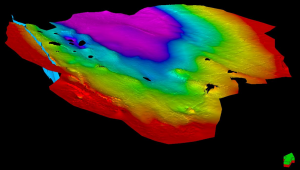Wed 16th May @ noon, Rm 312.222
Abstract:
The Petrel Basin is a NW-SE trending graben, orthogonal to and most likely older than the NE-SW trending structures that dominate the North West Shelf. The development of salt structures is closely related to the complex multi-phase evolution of the basin and the adjacent passive margin. Although not penetrated by wells, seismic stratigraphy clearly shows that salt was deposited as part of the syn-rift sequence, most likely of Devonian age. A significant phase of widespread mini-basin formation ensued and was terminated by the end of rifting. Hyper-extension during the Lower Palaeozoic resulted in the development of a thick Carboniferous to Triassic sag sequence during which some of the early formed structures evolved into high-relief point-sourced diapirs by a combination of early salt withdrawal and subsequent passive growth. Extensional fault reactivation in the Middle Jurassic, associated with more widespread rifting further outboard on the continental margin, resulted in accelerated subsidence in the basin centre, with extension on the basin margin being balanced by tightening of compressional salt cored folds and daipirs in the basin centre. A phase of compression, most likely associated with the collision of Australia with SE Asia in the Neogene, resulted in inversion of segments of the basin bounding fault system and a final phase of diapir growth.
Neoproterozoic and Lower Palaeozoic salt occurs in a number of Australian sedimentary basins. Although salt structures are associated with hydrocarbon occurrences in a number of these basins, the Petrel Basin is by far the most prolific. However, despite the large number of salt structures, the number of discoveries in the Petrel Basin is relatively small. Most hydrocarbon occurrences are associated with broad salt cored anticlines that developed during Jurassic extension, rather than high relief diapirs that experienced Cenozoic growth. The complex multi-phase growth of these latter structures most likely resulted in seal breach.
Short bio:
Chris Elders is Professor of Petroleum Geology at Curtin University. Having spent time at Oxford, in Shell and at Royal Holloway (university of London), Chris has enjoyed spending the last 4.5 years helping to unravel the complex evolution of Australia’s continental margins.
